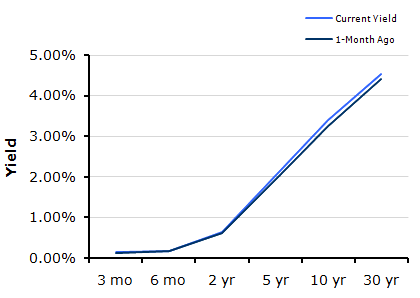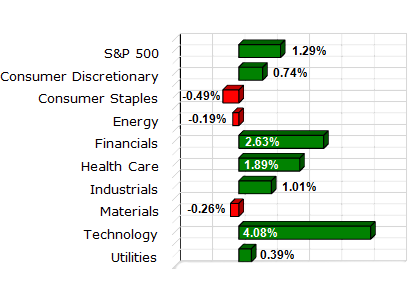
Market Commentary by Scott J. Brown, Ph.D., Chief Economist

The stock market began the year relatively optimistic about the 2011 economic outlook, but the week’s mixed economic data dampened the euphoria to some extent. The ISM surveys improved in December, but the employment gauges in those reports were relatively soft. While the holiday shopping season was deemed a great success, chain-store sales results were mixed (as many disappointments as upside surprises).
The December Employment Report was a mixed bag. The strong ADP estimate of private-sector payrolls (+297,000) led many economists to revise their forecasts of the official Bureau of Labor Statistics figure. The BLS payroll figure disappointed, rising by only 103,000, although a +70,000 revision to the two previous months took away some of the sting. Job gains were led by leisure and hospitality (+47,000) and healthcare (+35,700). Temp-help added 15,900 (+16.1% y/y). State and local government shed 20,000 (down 250,000, or 1.3%, over the last 12 months).
The unemployment rate fell to 9.4% from 9.8%, but part of that appears to have been an unwinding of a quirk that boosted the rate in November. In addition, the temporary lapse in extended unemployment insurance benefits likely reduced the rate in December. The employment-to-population ratio has been little changed over the last 12 months.
The December 14th FOMC minutes suggest that Fed officials have a high threshold for making changes to the asset purchase program. In testimony to the Senate Budget Committee, Fed Chairman Bernanke indicated that the Fed expects the economy to continue to improve, just not fast enough to bring the unemployment rate down rapidly. He noted problems associated with “very low” inflation and painted the asset purchase program as merely being similar to conventional monetary policy (that is rate cuts). He noted that the Fed returned $120 billion in interest payments to the Treasury in 2009 and 2010.
Next week, the important economic data bunch up on Friday. Retail sales are likely to post a moderately strong gain in December, boosted partly by higher gasoline prices. Higher gasoline prices will also show up in the Consumer Price Index (and will be amplified by the seasonal adjustment, which expects a decline). Industrial production is expected to have risen moderately.
Indices
| Last | Last Week | YTD return % | |
| DJIA | 11697.31 | 11569.71 | 1.03% |
| NASDAQ | 2709.89 | 2662.98 | 2.15% |
| S&P 500 | 1273.85 | 1257.88 | 1.29% |
| MSCI EAFE | 1648.65 | 1649.69 | -0.58% |
| Russell 2000 | 791.42 | 789.74 | 0.99% |
Consumer Money Rates
| Last | 1-year ago | |
| Prime Rate | 3.25 | 3.25 |
| Fed Funds | 0.25 | 0.25 |
| 30-year mortgage | 4.86 | 5.26 |
Currencies
| Last | 1-year ago | |
| Dollars per British Pound | 1.550 | 1.600 |
| Dollars per Euro | 1.303 | 1.441 |
| Japanese Yen per Dollar | 83.150 | 92.500 |
| Canadian Dollars per Dollar | 0.995 | 1.034 |
| Mexican Peso per Dollar | 12.223 | 12.732 |
Commodities
| Last | 1-year ago | |
| Crude Oil | 88.38 | 83.18 |
| Gold | 1373.75 | 1135.40 |
Bond Rates
| Last | 1-month ago | |
| 2-year treasury | 0.64 | 0.61 |
| 10-year treasury | 3.40 | 3.26 |
| 10-year municipal (TEY) | 5.23 | 4.72 |
Treasury Yield Curve – 1/7/2011

S&P Sector Performance (YTD) – 1/7/2011

Economic Calendar
| January 12th | — | Fed Beige Book |
| January 13th | — | Jobless Claims (week ending January 8th) Producer Price Index (December) Trade Balance (November) |
| January 14th | — | Consumer Price Index (December) Real Weekly Earnings (December) Retail Sales (December) Industrial Production (December) Consumer Sentiment (mid-January) Business Inventories |
| January 17th | — | Martin Luther King, Jr. Holiday (markets closed) |
| January 19th | — | Building Permits, Housing Starts (December) |
| January 25th/26th | — | FOMC Meeting |
| January 28th | — | Real GDP (4Q11, advance estimate) |
| February 2nd | — | State of the Union Address (also, Groundhog’s Day) |
Important Disclosures
Past performance is not a guarantee of future results. There are special risks involved with global investing related to market and currency fluctuations, economic and political instability, and different financial accounting standards. The above material has been obtained from sources considered reliable, but we do not guarantee that it is accurate or complete. There is no assurance that any trends mentioned will continue in the future. While interest on municipal bonds is generally exempt from federal income tax, it may be subject to the federal alternative minimum tax, state or local taxes. In addition, certain municipal bonds (such as Build America Bonds) are issued without a federal tax exemption, which subjects the related interest income to federal income tax. Investing involves risk and investors may incur a profit or a loss.
US government bonds and treasury bills are guaranteed by the US government and, if held to maturity, offer a fixed rate of return and guaranteed principal value. US government bonds are issued and guaranteed as to the timely payment of principal and interest by the federal government. Treasury bills are certificates reflecting short-term (less than one year) obligations of the US government.
Commodities trading is generally considered speculative because of the significant potential for investment loss. Markets for commodities are likely to be volatile and there may be sharp price fluctuations even during periods when prices overall are rising. Specific sector investing can be subject to different and greater risks than more diversified investments.
Tax Equiv Muni yields (TEY) assume a 35% tax rate on triple-A rated, tax-exempt insured revenue bonds.
![]() Material prepared by Raymond James for use by its financial advisors.
Material prepared by Raymond James for use by its financial advisors.
The information contained herein has been obtained from sources considered reliable, but we do not guarantee that the foregoing material is accurate or complete. Data source: Bloomberg, as of close of business January 6th, 2010.
©2010 Raymond James Financial Services, Inc. member FINRA / SIPC.


